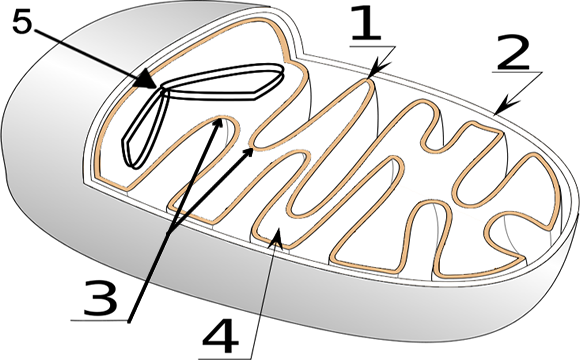How Does the Mitochondria Produce Energy for the Cell?
Mitochondria are the powerhouses of the cell because they “burn” or break the chemical bonds of glucose to release energy to do work in a cell. Remember that this energy originally came from the sun and was stored in chemical bonds by plants during photosynthesis.
Glucose and other carbohydrates made by plants during photosynthesis are broken down by the process of aerobic cellular respiration (requires oxygen) in the mitochondria of the cell. This releases energy for the cell. ATP is the energy-carrying molecule produced by the mitochondria through a series of chemical reactions. The more active a cell (such as a muscle cell), the more mitochondria it will have.

The mitochondria are about the size of a bacterial cell and are often peanut-shaped. Mitochondria have their own DNA and a double membrane. The outer membrane (2) is smooth, while the inner membrane (1) is convoluted into folds called cristae (3) in order to increase the surface area. The matrix (4) is the space contained within the inner membrane.
Color:
 Outer Membrane (green)
Outer Membrane (green)
 Inner Membrane / Cristae (red)
Inner Membrane / Cristae (red)
 Matrix (blue)
Matrix (blue)
 DNA (yellow)
DNA (yellow)
1. Why are mitochondria called the powerhouse of the cell?
2. What types of cells would have more mitochondria than others?
3. What simple sugar is broken down in the mitochondria?
4. Glucose is broken down by the mitochondria by what process?
5. In humans (and other animals) where does this glucose come from?
6. Why is this process called “aerobic?”
7. What energy-carrying molecule is created when the chemical bonds of glucose are broken?
The Chemistry of Cellular Respiration
Shown below is the chemical equation for cellular respiration with symbols for the reactants and products of the reaction.
Label the diagram below and color it.
 Glucose (purple)
Glucose (purple)  Oxygen (red)
Oxygen (red)  ATP (orange)
ATP (orange)
 Carbon Dioxide (green)
Carbon Dioxide (green)  Water (blue)
Water (blue)

8. Products are what is created during a reaction. What are the three products of cellular respiration?
9. Reactants are what goes into the reaction, what are the two reactants needed for respiration to occur?
10. What would happen if oxygen were not available?
11. Refer to your notes or textbook to write down the equation for PHOTOSYNTHESIS.
12. How are photosynthesis and cellular respiration similar?
Other Resources
Photosynthesis and Respiration Model - image shows the two processes are connected; students answer questions related to a graphic
Chemiosmosis Coloring - color the membrane and the steps involved in the production of ATP
Converting Light Energy into Chemical Energy - label of graphic of photosystems I and II


